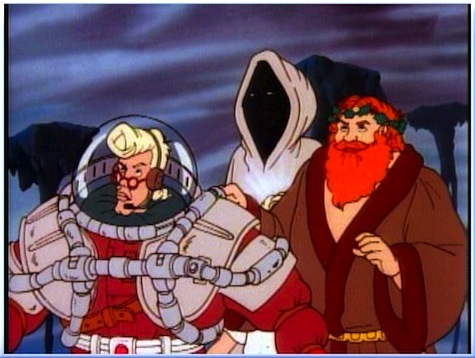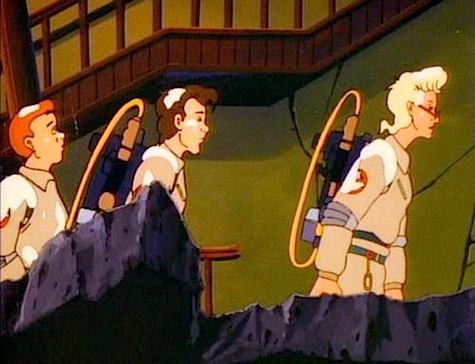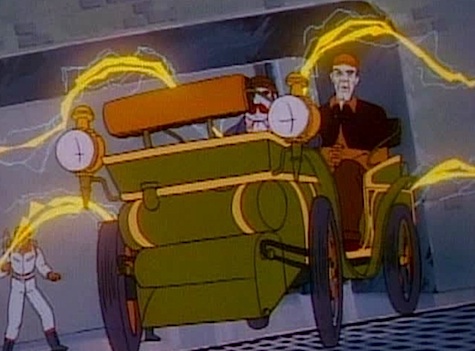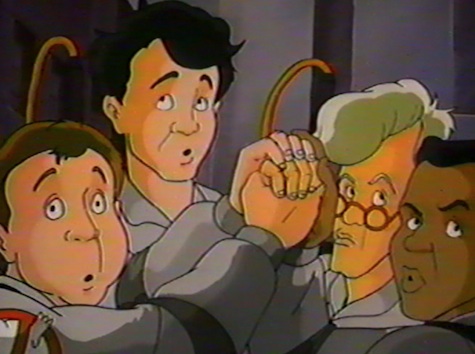We all love Ghostbusters and sometimes Ghostbusters 2, but what about the cartoon The Real Ghostbusters? What the hell was that thing? It’s populated by Ghostbusters who don’t look like themselves, brightly colored costumes, the guy who does the voice of cartoon Garfield, plus the seemingly inexplicable qualifying adjective “real” before the title of the show.
So this thing sucks, right? Well, yes and no. The most surprising thing we’ve all forgotten about The Real Ghostbusters is how genuinely creative some of the stories were. Here’s some samples of the awesome high-concept notions this forgotten cartoon peddled right under our noses.
6. The Writing Was Trying to be Smart
The first two seasons of The Real Ghostbusters were overseen by script editor J. Michael Straczynski. This is prior to JMS becoming the stalwart of science fiction with Babylon 5 and a comic book guru with Amazing Spider-Man, Thor and other titles. JMS’s background in 1986 was primarily television, his biggest credit at the time being He-Man & The Masters of the Universe. With Ghostbusters you get the sense JMS was already forming his own version of this science fiction universe as he explored the implications of how a ghost-busting organization would function on a day-to-day level. We see how their co-habitation operates, the demands on their time, and how their interests and their relationships with each other actually unfold. More importantly though, actual cool concepts were being floated right way. The FIRST regular episode of the show was called “Ghosts R Us” and featured a trio of escaped ghosts who set up their own rival ghost-busting service. Whaaat? The first episode tries to invert the premise of the show? Now, that’s what I’m talking about!

5. The Ghostbusters Do a Fair Amount of Time Travel
In the first season, not only do the boys travel back in time, they also seem to cross into a parallel dimension. The episode “X-Mas Marks the Spot” asserts casually that the events of the Charles Dickens story A Christmas Carol are actually true, or at the very least, in the same fictional universe as The Real Ghostbusters. After accidentally finding themselves transported back to a Victorian setting, the Ghostbusters zap and entrap the Ghosts of Christmas Past, Present, and Future. Upon returning to the present day, they find the world completely changed. Essentially, because Scrooge never reformed, his practices eventually became the world standard! The Ghostbusters must set right what is now wrong, resulting in Egon having to go into the containment unit and pull out the other ghosts. How do we feel about asserting the events of A Christmas Carol as historical fact on par with any other major historical event? Would Dickens be okay with the Ghostbusters? I think so.
Further, in a 5th season episode called “It’s About Time,” when the firehouse is threatened with being torn down in the present, the Ghostbusters randomly end up in 1957 where the firehouse is under attack from ghosts. After thwarting the ghosts and returning to the present, the boys have seemingly created a predestination paradox as the firehouse is now a historical landmark because it was saved by some mysterious strangers back in the ‘50’s! This makes Doctor Who’s “Father’s Day” look like a joke.

4. The Fictional Physics of the Ghostbusters Tech and Universe are Fleshed Out Considerably
Where do the ghosts go when they’re put in the traps? What’s the inside of the containment unit like? Is there a separate “world” in which the ghosts of this universe reside and how do we communicate with it? Why do certain ghosts stay on Earth and others don’t?
Almost all of these issues are addressed at some point, but the notions about what goes on inside of the Containment Unit are the most interesting. In the aforementioned “X-Mas Marks the Spot” Egon has to go inside of the machine, which is depicted as a kind of ethereal world with floating rocky platforms connected to nothing. A ghost purgatory, if you will. Not surprisingly, Slimer goes inside of the Containment Unit more than any other character, simply because he is already a ghost and getting him in is easy. (Note: there’s a creepy compliancy on Slimer’s part here. He’s okay with all of his ghostly brethren being imprisoned, and doing the dirty work for their jailers. Slimer of the cartoons may be the biggest example of someone with Stockholm Syndrome.) Notably Slimer goes in twice to get the Stay Puft Marshmallow Man out, because in this reality the Ghostbuster didn’t destroy the Marshmallow Man, but rather, “busted” him and stuck him in a trap.
All in all, the nerdiest interesting thing about the Containment Unit is that it’s…wait for it…bigger on the inside.

3. The Cartoon Asserts a Meta-Fictional Shell Around the Films
Before I explain to you how it is possible to reconcile the continuity of The Real Ghostbsuters cartoon with the events of the two films, consider the following: the character of Peter Venkman is played by Bill Murray in the movies, but voiced by Lorenzo Music in the cartoon. Now, Lorenzo Music is slightly more famous for providing the voice of Garfield in the Garfield cartoon. But, when a feature film of Garfield rolled around, Bill Murray did the voice. So, clearly a dimension doorway is swinging between cartoons and real life already.
The real reason the show is called “The Real” Ghostbusters is because there was another cartoon called Ghostbusters which had nothing to do with anything. The producers wanted kids to know this was the “Who ya gonna call?” guys and not some posers. And yet. They are kind of posers, right? I mean, they don’t actually look anything like Bill Murray, Dan Aykroyd, Ernie Hudson, or Harold Ramis. (Interestingly, Annie Potts’ portrayal of Janine in Ghostbusters 2 looks more like the cartoon version of Janine than she does in the first film.)
So what’s the deal? Well, the in-universe explanation for this discrepancy is that the Ghostbusters of the cartoons are the real Ghostbusters and the films exist within their fictional world as films based on their lives. Think of the Ghostbusters movies then as the published Watson adventures of Sherlock Holmes, and the Ghostbusters cartoon as the actual, raw source material.
While some of this is alluded to in “Citizen Ghost,” the straight-up metafiction all goes down in an episode called “Take Two” which involved a movie being made about the life of the Ghostbusters. Cartoon Winston believes the names “Ramis, Aykroyd, and Murray” sound like a “law firm.” After a good deal of antics, the boys end up attending the premier where Peter complains movie-Peter looks nothing like him.

2. The Definition of “Ghost” is Blurred in a Big Way
Unlike the Slimer of the first film, who had liquid pouring through him as he drank it, the Slimer in the cartoon seems to be able to actually consume large amounts of food and liquid. For a “ghost,” he always seems to be hungry, which makes no sense. And really, if you get right down to it, most of what the Ghosbusters fight with (or co-habit with) are more like monsters and less like ghosts. This is oddly similar to the film, since most of what they deal with are terrible, demon-like creatures. The Stay Puft Marshmallow Man isn’t “the ghost of the Stay Puft Marshmallow Man” instead, he’s a conjured-up demon, technically a kind of demi-god. The Ghostbusters don’t really bust legit ghosts!
This gets even weirder in an episode called “Elementary, My Dear Winston” in which the belief in Sherlock Holmes and Doctor Watson manifests real life versions of them in the actual, physical world, which Egon calls “ghosts.” At this point the word “ghost” is really more like a “spirit” or a manifestation of something unreal. From this perspective, the “ghosts” in “Ghostbusters” are simply “the unreal.” But The Real Unreal-Busters would have probably been a terrible title.

1. Arsenio Hall Played the Voice of Winston for Three Seasons
Yep.
Ryan Britt is a staff writer for Tor.com.











That was Arsenio Hall? I love the show all the more now, knowing that.
Look…
As long as you covered the Lorenzo Music/Bill Murray thing, you’re OK in my book. :) Of course, in my book it is normal to know a whole lot about The Real Ghostbusters, so take it for what it’s worth.
Forgotten? Sucks? No way!
The cartoon does the one thing that the movies don’t – establishes the Ghostbusters as a longterm business that faces a wide variety of stuff. If you go just by the movies they’d have only really gone up against the supernatural twice, with 5 years of dead time between them. That gives the cartoon as a whole a more epic feel than the movies, to me.
Sure, cartoon Venkman isn’t as funny as Bill Murray, but you can’t expect that – it was a Saturday morning cartoon from before the modern golden age of cartoons. It was better than 90% of what was on at the time.
If you honestly don’t have fond memories of this, your childhood must have been a strange, hollow place. Seriously, I thought everyone loved this!
Point #2: “For a “ghost,” he always seems to be hungry, which makes no sense.”
Eastern ghosts are legendarily hungry. I think it’s Tor.com that turned me onto Yang Chang Compestine’s A Banquet for Hungry Ghosts. In the author’s note at the beginning, she says, “China has a long tradition of honoring the dead with food, stemming from the belief that hungry ghosts linger on to haunt the living.” Irish legends, too, have stories of the dead coming back to the dinner tables and eating every last morsel, though I don’t know if those particular spirits are called ghosts. On the Day of the Dead, families bring picnics to the cemetary with the expectation that the spirits of their departed relatives will join them for a bite. Slimer’s gluttony (and his inability to fulfil it) seems very ghost-like to me. For all I know, it’s why he’s still restless.
I have fond memories of the episode “The Collect Call of Cthulhu”.
“Cthulhu makes Gozer look like Little Mary Sunshine.”
I totally remember this cartoon and loved it. I guess the “real” part is inexplicable if you don’t remember the other Ghostbusters cartoon (by Filmation) that was running at about the same time.
I’ve really really wanted to watch these over again, but have been afraid that the Suck Fairy might have intervened and ruined my fond memories of the show. I suppose it’s high time to set those concerns aside and begin the rewatch posthaste. Thanks for this.
oops. Sorry. I missed where you mentioned the other Ghostbusters cartoon. apologies.
In its first couple of seasons, when JMS was the story editor, this was a great show. Unfortunately, it was only really able to come into its own in the episodes that aired in first-run syndication, which was basically just episodes 14-65. All the rest were on ABC Saturday mornings and were subject to much more censorship and kiddification.
But those first couple of seasons were really great stuff, quite cutting-edge for animation of the time. RGB was a pioneer in taking American animated TV in a more sophisticated direction, and without it, we might not have had the likes of Batman: The Animated Series and Gargoyles further down the road. It deserves a lot more credit than it gets. And it had an impressive roster of SF/fantasy writers contributing to it.
The production values were terrific too. The cast was great, not just Music and Hall, but Maurice LaMarche (aka the Brain from Pinky and the Brain, aka Kif, Morbo, Calculon, and countless other Futurama characters) as Egon and the ubiquitous Frank Welker as Ray and Slimer (and most of the ghosts/monsters), plus Laura Summer as the original Janine (before she got de-accented and prettified by network mandate). The music by Shuki Levy and Haim Saban (who did practically every animated show’s music at the time) was probably their finest work, with a rich mix of musical styles and some really effective danger/chill cues. And the animation in the first couple of seasons was generally excellent. Though the animation house wasn’t specified in the credits, it looks to me like it bears the characteristic art and movement style of Tokyo Movie Shinsha, whose work has always impressed me.
By the way, about the other Ghostbusters cartoon: actually Filmation used the name first, in a live-action ’70s show called The Ghost Busters starring Larry Storch, Forrest Tucker, and Bob Burns in a gorilla suit. Columbia had to sue Filmation for the rights to the name when they made the movie, and the settlement let Filmation retain the right to use the title themselves. So when the movie was a hit, Filmation naturally capitalized on its success by creating an animated sequel to their original series (revolving around the sons of Storch & Tucker’s characters). That’s why it was possible for two competing shows to legally use the name at the same time. The Filmation version was initially announced as The Original Ghostbusters, but ended up just being called Filmation’s Ghostbusters.
My favorite story from jms about his working on the show is how they had to change Janine’s glasses to be round instead of pointy because children don’t like pointy things….